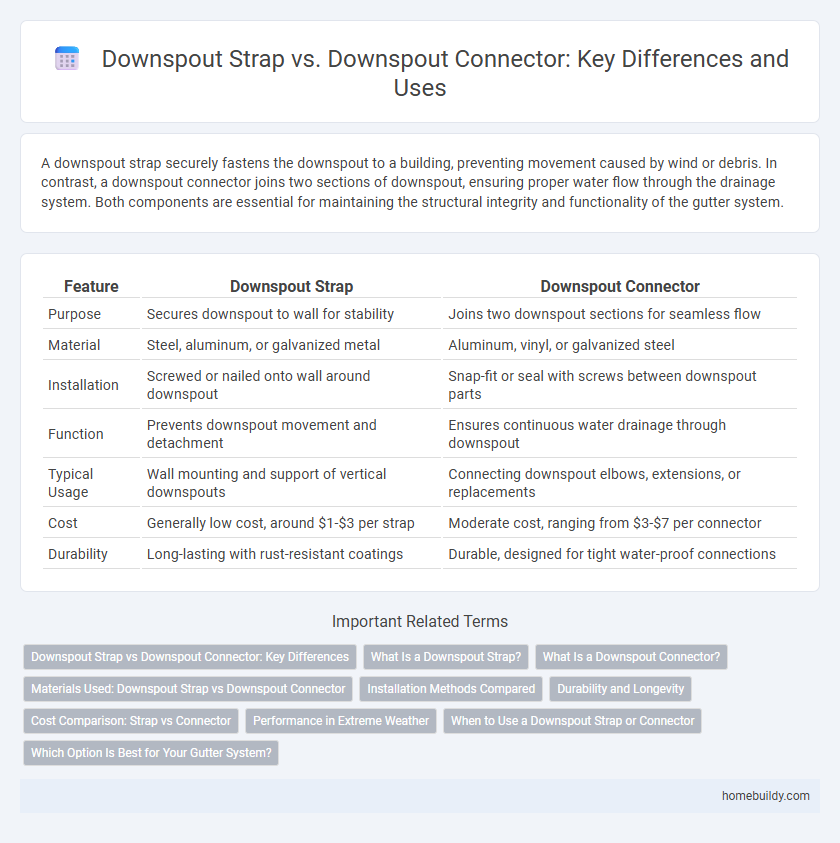A downspout strap securely fastens the downspout to a building, preventing movement caused by wind or debris. In contrast, a downspout connector joins two sections of downspout, ensuring proper water flow through the drainage system. Both components are essential for maintaining the structural integrity and functionality of the gutter system.
Table of Comparison
| Feature | Downspout Strap | Downspout Connector |
|---|---|---|
| Purpose | Secures downspout to wall for stability | Joins two downspout sections for seamless flow |
| Material | Steel, aluminum, or galvanized metal | Aluminum, vinyl, or galvanized steel |
| Installation | Screwed or nailed onto wall around downspout | Snap-fit or seal with screws between downspout parts |
| Function | Prevents downspout movement and detachment | Ensures continuous water drainage through downspout |
| Typical Usage | Wall mounting and support of vertical downspouts | Connecting downspout elbows, extensions, or replacements |
| Cost | Generally low cost, around $1-$3 per strap | Moderate cost, ranging from $3-$7 per connector |
| Durability | Long-lasting with rust-resistant coatings | Durable, designed for tight water-proof connections |
Downspout Strap vs Downspout Connector: Key Differences
Downspout straps secure downspouts to the exterior of a building, providing support and preventing movement due to wind or impact, whereas downspout connectors join sections of downspouts to ensure a continuous water flow path. Straps are typically metal bands fastened around the downspout and attached to walls, prioritizing structural stability, while connectors are couplings or sleeves designed to fit inside or overlap pipe ends for seamless drainage. Understanding these functional differences helps in selecting the right component for maintaining gutter system integrity and effective water management.
What Is a Downspout Strap?
A downspout strap is a metal fastener designed to securely attach downspouts to the exterior walls of a building, ensuring stability and preventing movement during heavy rain or wind. Unlike a downspout connector, which joins sections of the downspout system together for seamless water flow, a downspout strap primarily serves as a mounting support that maintains the positioning of the downspout against the structure. These straps are typically made of galvanized steel or aluminum for corrosion resistance and durability in various weather conditions.
What Is a Downspout Connector?
A downspout connector is a specialized fitting used to link sections of a downspout, ensuring a secure and watertight connection for efficient rainwater drainage. Unlike downspout straps, which primarily secure the downspout to a structure, connectors join downspout pieces to maintain continuous water flow. This component is essential for preventing leaks and directing rainwater away from the building's foundation.
Materials Used: Downspout Strap vs Downspout Connector
Downspout straps are typically crafted from galvanized steel or stainless steel for durability and resistance to rust, offering strong support to secure downspouts to walls. Downspout connectors often use materials like aluminum or PVC, prioritizing lightweight construction and ease of installation while providing a watertight seal between downspout sections. The selection between strap and connector depends on the required strength and weather resistance for the specific building application.
Installation Methods Compared
Downspout straps secure downspouts to the building exterior using simple metal bands fastened with screws or nails, allowing easy adjustments and removal. Downspout connectors join sections of downspouts together by slipping one end into another and sealing with screws or rivets, ensuring a watertight connection. Installation of downspout straps is generally faster and less permanent compared to the precise alignment and sealing required for downspout connectors.
Durability and Longevity
Downspout straps offer superior durability by securely fastening the downspout to the structure, reducing movement and wear over time, while downspout connectors primarily join sections and may be prone to loosening or corrosion in extreme weather conditions. Straps made from galvanized steel or stainless steel provide enhanced longevity compared to plastic or lower-grade metal connectors, ensuring long-term stability and resistance to rust. Properly installed downspout straps extend the lifespan of drainage systems by maintaining solid attachment, minimizing damage caused by wind or debris impact.
Cost Comparison: Strap vs Connector
Downspout straps typically cost less than downspout connectors, with straps priced around $1 to $3 each, making them an affordable option for securing downspouts to walls. Downspout connectors, which join sections of downspouts, generally range from $3 to $7 or more depending on material and design, resulting in higher overall expenses for installation. Choosing downspout straps offers a cost-effective solution for stability, while connectors incur additional costs due to their functional complexity in gutter systems.
Performance in Extreme Weather
Downspout straps provide superior stability during extreme weather by securely fastening downspouts to a structure, preventing detachment from high winds or heavy rain. Downspout connectors primarily link sections of downspouts together but offer limited resistance against strong gusts or ice buildup. Therefore, downspout straps enhance overall system durability and performance under severe weather conditions compared to downspout connectors.
When to Use a Downspout Strap or Connector
Use a downspout strap when securing the downspout to the building's exterior for stability and wind resistance, typically along walls or corners. Choose a downspout connector to join two sections of downspout together or to attach the downspout to the gutter system, ensuring a continuous channel for water flow. Proper selection depends on whether the goal is fastening or connecting; straps provide support, while connectors maintain the downspout's structural integrity.
Which Option Is Best for Your Gutter System?
Downspout straps provide sturdy support by securely fastening downspouts to a building's exterior, preventing movement and damage in strong winds or heavy rain. Downspout connectors, on the other hand, are designed to join sections of downspouts, ensuring a seamless flow of water from gutters to drainage systems. For optimal gutter system performance, use downspout straps to stabilize the assembly and downspout connectors to maintain water-tight connections, combining both solutions for maximum durability and functionality.
Downspout strap vs Downspout connector Infographic

 homebuildy.com
homebuildy.com